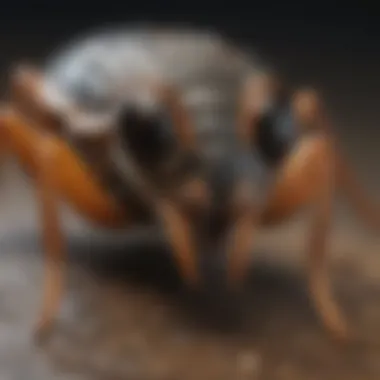Comprehensive Pest Control Strategies for Springtown


Intro
In Springtown, TX, managing pests is not just about keeping a neat home; it’s a crucial responsibility that ensures the health and safety of families. As the weather warms up, various pests become active, making it essential to recognize and address any issues promptly. This article serves to equip homeowners with knowledge regarding pest identification, effective management strategies, and eco-friendly practices that can be implemented in their homes and gardens.
Understanding the common pests in the Springtown area is fundamental. Awareness allows homeowners to act swiftly to mitigate invasions before they escalate. Furthermore, this guide discusses practical prevention methods and DIY pest control solutions, empowering residents to manage their spaces sustainably and efficiently. A collaborative approach between residents and professional pest management services is also emphasized for those looking for an extra layer of protection.
Pest Identification
Identifying pests accurately is the first step in effective management. Different pests exhibit various behaviors and signs of infestation, which can help in recognizing their presence early.
Common Household Pests
In Springtown, homeowners frequently encounter pests such as:
- Ants: These insects can invade kitchens and gardens, often in search for food.
- Cockroaches: Roaches thrive in warm environments and may pose health risks.
- Termites: Known for causing severe structural damage, they often go unnoticed until significant harm has occurred.
- Rodents: Mice and rats not only invade spaces but can bring diseases and cause property damage.
Signs of Infestation
Recognizing the signs of infestation is essential. Key indicators include:
- Droppings or urine stains: Often found in areas frequented by the pests.
- Gnaw marks: Typically discovered on packaging or furniture.
- Unusual noises: Scratching or squeaking sounds can suggest rodent activity.
- Nesting materials: Clutter and debris may indicate a larger nest nearby.
"Timely identification is crucial in preventing a small pest problem from turning into a full-blown infestation."
Prevention Methods
Effective prevention methods can significantly reduce the likelihood of pest infestations. Taking proactive measures protects homes and gardens.
Environmental Modifications
Adjusting the environment can deter pests effectively. Some approaches include:
- Seal entry points: Close any cracks or gaps in walls, windows, and doors.
- Manage moisture: Fix leaks and use dehumidifiers to reduce damp areas that pests thrive in.
- Maintain landscaping: Keep shrubs trimmed and remove debris where pests may hide.
Home Maintenance Tips
Routine home maintenance is also crucial. Consider these practices:
- Regularly clean all areas, focusing on kitchens and dining areas.
- Store food in sealed containers to avoid attracting pests.
- Dispose of trash properly and frequently to reduce litter around the home.
DIY Pest Control Solutions
For homeowners who prefer to manage pest problems themselves, various DIY solutions exist. These simple yet effective methods often involve using natural ingredients available in most households.
Natural Remedies
Several natural remedies can repel or eliminate pests:
- Vinegar: Acts as a disinfectant and can deter ants.
- Boric acid: Works well against cockroaches when used properly.
- Essential oils: Such as peppermint or tea tree oil can repel insects when diluted with water.
DIY Traps and Barriers
Homemade traps and barriers can also be effective. Some ideas to consider include:
- Setting up simple traps using jars or bottles with bait to catch rodents.
- Creating barriers with diatomaceous earth around entry points to prevent insects from passing.


Understanding Pest Control
Pest control is a crucial aspect of maintaining a healthy and safe living environment. In Springtown, TX, pest infestations can have various implications for residents, encompassing health risks to potential property damage. An understanding of pest control equips homeowners with the knowledge to identify, prevent, and effectively manage pest issues.
The importance of understanding pest control lies in several key factors. Firstly, recognizing the common types of pests in Springtown aids in preventive actions. Different pests require tailored approaches due to their unique behaviors and life cycles. For instance, termites can cause significant structural damage if left unchecked. Understanding their habits and the signs of their presence is essential for timely intervention.
Additionally, knowledge about pest control helps in making informed decisions regarding management strategies. Homeowners can choose to adopt preventive measures, implement DIY solutions, or seek professional services based on the severity of the infestation and their specific needs. Knowing the options available encourages a proactive stance against pests, which can ultimately save time, effort, and money.
Moreover, understanding pest control also involves awareness of environmental considerations. The methods used in pest management can have varying impacts on local ecosystems. By recognizing the importance of sustainable practices, homeowners can contribute to the wellbeing of their environment while dealing with pest problems.
In summary, understanding pest control is vital for the safety and comfort of any home. It provides homeowners with the tools and knowledge needed for effective pest management, helping them to achieve a pest-free living space.
Definitions and Importance
Pest control generally refers to the regulation or management of a species defined as a pest, often impacting health, economics, or the environment. It encompasses a range of techniques and methods aimed at preventing and eradicating unwanted organisms. This definition highlights the necessity of a comprehensive approach to pest management rather than a reactive one.
The importance of pest control is multifaceted. From a health perspective, many pests, such as rodents and insects, can transmit diseases to humans and pets. Effective control measures mitigate these risks, ensuring a safer living environment. Furthermore, pests may cause significant financial damage. For example, termite infestations can lead to costly repairs if not addressed in a timely manner. Therefore, an understanding of pest control strategies can protect both health and financial investment.
The Role of Pest Control Specialists
Pest control specialists play a critical role in managing and mitigating pest infestations. Their expertise involves not only eradicating existing pests but also preventing future infestations. Specialists are trained to identify various pest species, assess the nature of the infestation, and recommend appropriate management techniques.
These professionals utilize integrated pest management (IPM) practices, which consider the lifecycle and behavior of pests while minimizing harm to non-target organisms and the environment. This is particularly important in areas like Springtown, where local ecosystems and wildlife can be affected by pest control measures.
Homeowners may benefit from hiring pest control specialists when facing severe infestations, as these experts can provide tailored treatment plans and ongoing monitoring. Understanding their role emphasizes the importance of professional intervention in maintaining a pest-free home.
Common Pests in Springtown, TX
The issue of pests in Springtown, Texas, requires careful attention. Various types of pests inhabit this region, often leading to potential damage or health risks. Recognizing common pests and understanding their behaviors is vital for effective pest management. This section will help homeowners identify prevalent pest species and underscore their importance in pest control strategies.
Insects
Ants
Ants are one of the most typical insects found in Springtown. They play essential roles in the ecosystem, such as aerating the soil and breaking down organic material. This makes them beneficial elements to the environment. However, their presence indoors can signify problems. It is important to identify their trails and nesting sites. Their ability to form colonies can lead to significant infestations if not managed promptly. The adaptability of ants to various conditions means they can be a persistent issue for homeowners.
Termites
Termites are extremely damaging pests as they feed on wood, causing structural issues in homes. Their silent approach often leads to severe damage before detection. The primary feature of termites is their capacity to consume cellulose, which includes wood in homes. This attribute makes them a grave threat, especially in areas with wooden constructions. Detecting termites early is crucial to minimize repair costs and history of infestations in residences.
Wasps and Bees
Wasps and bees contribute significantly to pollination, making them essential for local agriculture. While they support the ecosystem, their presence near homes can be alarming due to the potential for stings. Wasps tend to be more aggressive, and their nests can pose risks if disturbed. Also, unlike bees, they do not die after stinging, increasing the threat they pose. Understanding the behavior of these pests is crucial for managing encounters safely.
Rodents
Rats
Rats are notorious for invading homes in search of food. Their adaptability allows them to thrive in various environments. A notable aspect of rats is their rapid breeding cycles, which can lead to explosive population growth. Therefore, addressing infestations quickly is important. Additionally, rats can transmit diseases, presenting health risks to humans and pets. The damage they cause to wires and structures also creates a need for effective management.
Mice
Mice may seem harmless, but they share many concerns with rats. They are equally capable of causing property damage and transmitting diseases. Mice can enter through tiny openings, making them challenging to exclude. Their nesting habits can frequently lead to contaminated food supplies. Similar to rats, their population can grow rapidly, necessitating proactive measures for control and prevention.
Wildlife


Squirrels
Squirrels are common in Springtown, often spotted in yards and parks. They can pose a threat by nesting in attics or damaging gardens. While typically not dangerous, they can chew through wires or insulation, leading to further issues. Their characteristic ability to adapt to urban environments can lead to conflicts with homeowners.
Raccoons
Raccoons are known for their dexterity and intelligence. They can cause various problems, including rummaging through trash and causing property damage. Their nocturnal habits often lead to disturbances at night, and their presence can attract other pests. Raccoons also pose health risks through their saliva and feces, making them a concern for human health and safety.
Possums
Possums are often misunderstood as harmful pests. In reality, they are generally harmless to humans. They help control pests like ticks and cockroaches. However, their scavenging behavior might lead them into inappropriate areas, causing concerns among homeowners. Their unique defense mechanism of playing dead can often confuse observers, but recognizing their benefits is essential for pest management strategies.
Identifying Pest Infestations
Identifying pest infestations is a critical aspect of effective pest management. InSpringtown, Texas, where various pests can disrupt homes and gardens, recognizing their presence early can save considerable time and resources. Pest infestations can lead to property damage, health risks, and emotional distress for homeowners. Thus, knowing the signs and understanding how to differentiate between similar pests is essential for appropriate responses. By being vigilant, residents can effectively manage their spaces, ensuring a safer and healthier environment.
Signs of Pest Presence
Several indicators can signal the presence of pests in a home. It is crucial to be keen on your observations:
- Droppings: Most pests leave droppings, which can vary in size and shape. Ants might leave tiny pellets, while rodents leave larger, rounded droppings.
- Nesting Materials: Look for signs of nesting, such as shredded paper, fabric, or insulation stuffed into hidden locations.
- Gnaw Marks: Rodents often gnaw on wood, wires, and even plastic, leaving behind chew marks.
- Visible Pests: Spotting pests scuttling across floors or walls can also be a clear sign.
- Unusual Sounds: Scratching or scuttling noises, particularly in the evening or night, often indicate animal activity in walls or attics.
Understanding these signs can aid homeowners to act quickly before the infestation worsens.
Differentiating Between Pests
Recognizing the specific type of pest is paramount for effective control. Schould you be facing an ant problem, for instance, the approach would vary greatly depending on whether they are carpenter ants or sugar ants. Each type comes with its own behavior patterns and treatment solutions. Here’s how to differentiate:
- Ants: Carpenter ants typically create nests in wood and are often larger than other types, while sugar ants can be slightly smaller and are drawn to food sources.
- Rodents: Rats usually are larger and preferred urban areas, whereas mice tend to inhabit more rural spaces and are smaller. Their droppings and forward-facing teeth may help in identification.
- Wildlife: Squirrels tend to create nests in trees, whereas raccoons are more likely to scavenge through trash cans.
"Understanding which pest is invading your space is the first step to effective management."
Each type of pest dictates a specific approach when it comes to control solutions, making identification crucial not only for efficacy but also for efficiency in pest management. By recognizing these differences, homeowners can tailor their strategies and choose suitable methods to rid their residences of unwanted guests.
Effective Pest Management Strategies
Effective pest management strategies are crucial for maintaining a safe and comfortable living environment in Springtown, TX. Pests can cause significant damage to property and pose health risks to residents. Implementing a well-thought-out management strategy helps reduce the likelihood of infestations and ensures long-term protection.
The importance of controlling pests cannot be understated. Establishing effective strategies enables homeowners to minimize issues related to unwanted animals. By addressing potential problems proactively, residents can save time and money in the long run. A balanced approach often includes preventive measures, DIY solutions, and professional services.
Preventive Measures
Sealing Entry Points
Sealing entry points is an essential preventive measure. Homes often have gaps and cracks that allow pests to enter. This simple action contributes significantly to reducing pest access and blocking their pathways. One key characteristic is that it acts as an efficient barrier without the need for harmful chemicals.
Sealing entry points is a beneficial choice for preventing infestations. It does not require specialized knowledge or tools; homeowners can usually perform it. Unique features include using materials like caulk or screen to close gaps. The advantages of this strategy are clear: it reduces pest access and is cost-effective, though diligence is required to regularly check for new openings.
Proper Waste Management
Proper waste management plays a substantial role in pest control. Properly managing refuse not only keeps spaces tidy but also minimizes food sources for pests. A key characteristic of this strategy is its ability to deter pest attraction by limiting odor and access to food waste.
It is a popular choice among homeowners because it promotes a clean environment. The unique feature includes using sealed containers for garbage and ensuring regular disposal. Advantages include lower chances of attracting pests, but if waste management is inconsistent, it may fail to achieve desired results, which could lead to new pest issues.
DIY Pest Control Solutions


Natural Remedies
Natural remedies are often favored for their eco-friendly approach. Many homeowners look for alternatives to chemical pesticides, making this a significant aspect of pest control. A key characteristic of natural remedies is their reliance on organic ingredients, such as essential oils and vinegar.
Residents find natural remedies beneficial as they reduce chemical exposure. Unique features may include homemade sprays that deter pests without environmental hazards. Advantages include safety around children and pets, although they can sometimes be less effective than synthetic options in severe infestations.
Traps and Baits
Traps and baits serve as effective DIY solutions for managing pests. These tools directly target the problem rather than just repelling it. A key characteristic is the versatility—various types are available for different pest species.
Choosing traps and baits is advantageous due to their immediate results. Unique features might include snap traps for rodents or sticky traps for insects. Advantages include ease of setup and visibility of success, but the disadvantage is that they may not address larger infestations without follow-up measures.
Professional Pest Control Services
Choosing the Right Service
Choosing the right service is critical for successful pest management. Homeowners must research and select a service that meets their specific needs. A key characteristic is that professional services offer tailored solutions based on the type of pests and severity of the problem.
This choice often helps ensure comprehensive coverage and effectiveness. Unique features include thorough inspections and customized treatment plans. The advantages are significant, including expert knowledge, though costs might be a concern for some homeowners.
Understanding Treatment Plans
Understanding treatment plans is essential for informed decisions about pest control. Homeowners should grasp what to expect, including methodologies and timelines. A key characteristic is the transparency of these plans, outlining the steps involved in the process.
This understanding enables homeowners to feel secure in the treatment process. Unique features might consist of follow-up visits and ongoing monitoring. The advantages of clear communication through a treatment plan help avoid confusion, while the disadvantage could be the time commitment required for repeated treatments.
Environmental Considerations
In pest control, environmental considerations play a crucial role. Understanding how pest management strategies affect local ecosystems is essential for homeowners and pest control professionals alike. Adopting eco-friendly methods mitigates adverse impacts on wildlife and helps maintain a balanced ecosystem. Furthermore, with the growing awareness surrounding environmental preservation, exploring sustainable pest control practices becomes more relevant than ever.
Sustainable Pest Control Practices
When discussing sustainable pest control practices, it is important to recognize various methods that aim to minimize harm to the environment. Some effective strategies include:
- Integrated Pest Management (IPM): This is an ecological approach that combines biological, cultural, physical, and chemical tools. It focuses on pest monitoring and establishing thresholds before applying any control measure.
- Non-Toxic Solutions: Utilizing natural repellents, such as essential oils or diatomaceous earth, helps manage pests sustainably. These products are less harmful to beneficial insects and humans.
- Habitat Modification: Altering the environment can deter pests from invading. Simple changes like better drainage, removing standing water, and keeping gardens well-maintained can significantly reduce pest attraction.
Implementing these practices not only reduces chemical dependency but also leads to healthier living spaces. Homeowners can contribute to environmental stewardship through their pest control options.
Impact of Chemicals on Local Ecosystems
The impact of chemicals on local ecosystems cannot be overlooked. Pesticides and other chemical agents can have far-reaching consequences, affecting not just the targeted pests but also non-target organisms, including beneficial insects and local wildlife. Harmful chemicals can seep into the soil and waterways, disrupting habitats and contaminating drinking water.
Key concerns include:
- Biodiversity Loss: Chemical usage can lead to a decline in beneficial species, disrupting the food chain and impacting pollination processes.
- Resistance Development: Overuse of chemical pesticides can lead pests to develop resistance, making future control measures less effective.
- Human Health Risks: Chemical exposure can pose risks to human health, especially for children and pets.
"Using chemicals indiscriminately can yield immediate benefits but often leads to longer-term consequences that disrupt local ecology."
Epilogue
In the realm of pest control, understanding the nuances presented in this article is paramount for homeowners and DIY enthusiasts alike. The key takeaway is the significance of adopting a comprehensive approach towards pest management, which not only tackles existing pest issues but also proactively prevents future infestations.
Pest management is not merely about removing unwanted creatures from a property. It's about fostering a safe and healthy environment for families. Recognizing the specific pest species prevalent in Springtown, TX, enables individuals to tailor their control strategies effectively. Likewise, employing environmentally sustainable practices ensures that actions taken today do not harm local ecosystems and contribute positively to the long-term welfare of the community.
A critical element of pest control relies on the differentiation between pest types. This understanding empowers homeowners to make informed decisions regarding treatment options. Whether choosing DIY solutions or professional services, being knowledgeable about pest behavior and life cycles is beneficial.
Let's summarize some of the essential points discussed:
- Identify Common Pests: Understanding common pests in Springtown, such as ants, termites, and rodents, aids in early detection.
- Preventive Measures: Sealing entry points and adhering to proper waste management practices significantly reduce the risk of infestations.
- Diverse Control Options: Homeowners have a spectrum of options, ranging from natural remedies and traps to professional pest control services.
- Environmental Awareness: Sustainable practices in pest management safeguard the local ecology while addressing pest concerns.
The most crucial consideration in pest control is not just eradication but a balanced approach to future prevention, ensuring a healthy living space.















